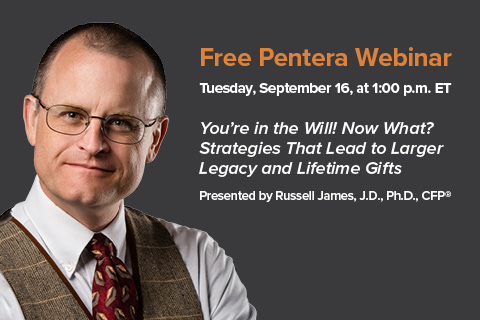The Pentera Blog
Who's In and Who's Out? The 4 Markets You Better Not Ignore
You may have one or more massive donor lists and need to pare down the number you plan to contact. But how do you decide who's in and who's out? One way is to look at broad categories of those who are likely to be more open to a planned gift: the wealthy, women, volunteers, and loyal donors. There are solid reasons, based on academic research and Pentera's vast experience, that these four groups are likely to include prime candidates for planned gifts.
The Wealthy
It seems obvious that those with a greater capacity to give are more likely to give, and that is now true, though it was not always so. Rich nobles in many societies gave most of their wealth to their immediate descendants and did little or nothing for the masses. Industrialist Andrew Carnegie launched the American philanthropic movement with an 1889 essay titled "The Gospel of Wealth." It lauded capitalism and the creation of an upper class but then gave that upper class an awesome responsibility: "This, then, is held to be the duty of the man of wealth: … to consider all surplus revenues which come to him simply as trust funds, which he is called upon to administer … to produce the most beneficial results for the community." He then went on to warn his fellow millionaires, "The man who dies leaving behind many millions of available wealth ... will pass away 'unwept, unhonored, and unsung.'"
Carnegie's seminal essay triggered the creation of numerous family foundations, and later community foundations. He gave away more than 90% of his fortune and is best known for building more than 3,000 libraries, plus numerous museums and concert halls, and starting the TIAA-CREF pension program. Warren Buffett and Bill Gates have continued the tradition with the "Giving Pledge," in which wealthy individuals commit to giving away at least half of their fortunes.
Currently, about 14% of the wealthiest Americans (top 20%) include a charitable estate recipient. For the next wealthiest group, the figure drops to 6%, and the numbers decline from there. A wealthy donor who volunteers is even more likely to include a charitable recipient.
Women
The fact is that women are more charitable than men. That's not saying anything against men; it's saying something good about women. Study after study—including Women Give 2010 and Women Give 2012 by the Women's Philanthropy Institute at Indiana University—has found women to be more charitable, even though there are numerous reasons they might not be: women on the average earn less money, spend fewer years in the labor force, and have smaller retirement incomes … but live longer, spend more on long-term care, and are more likely to live alone in their elder years.
"The results might seem illogical," commented Debra Mesch, director of the Women's Philanthropy Institute, after the release of Women Give 2012. Then she explained the reasons: "Women are socialized to be the caregivers of their families and communities. Previous research has also found that women tend to score higher on empathy and caring than men—factors that affect giving to charity. Similarly, women have been shown to be more altruistic than men, and their giving is frequently motivated by the desire to make a difference in peoples' lives."
On top of being more charitable, women are controlling more wealth than ever before. They already control more than half the wealth in the United States and are projected to inherit 70% of the intergenerational wealth in the next 50 years. One study found that more than 68% of those making legacy pledges were female. Widows and women who are childless give even more than other women.
Volunteers
It makes sense that those who volunteer for an organization will also support it financially if they have the ability to do so, both with annual gifts and planned gifts. The statistics bear that out: People who both give and volunteer are about twice as likely to plan a charitable estate gift (bequest or trust) as those who volunteer or give (but not both), according to American Charitable Bequest Demographics, a study by Russell James of Texas Tech University.
Some volunteers give regularly but in modest amounts. Others are giving their time because they don't have much treasure to offer. But all volunteers should be considered candidates for planned gifts; they may be able to give later what they can't give now.
In his study James analyzed the giving and volunteering habits of those who make charitable bequests in a will or trust. Among those with planning documents in 2010:
- 17.6% of those who volunteered and gave at least $500 planned a charitable estate gift.
- 8.5% of those who gave at least $500 but did not volunteer planned a charitable estate gift.
- 7.5% of those who volunteered but gave less than $500 planned a charitable estate gift.
Old Friends (former donors)
As people age they typically stop making annual gifts to charity. But that does not mean that they have not made a bequest—or would consider one. More than 83% of charitable bequests come from decedents 80+, according to James, and many of those donors stop annual giving in the years approaching death. Of those who actually make charitable gifts in their estates, 36% repeatedly said they had no charitable component in their estate plans but changed their minds and added a gift within two years of death.
The key is to keep in touch with formerly loyal donors, those Pentera likes to call old friends. They may have already included a bequest that you want them to keep—or they may have no charitable bequest but are willing to add one. Those who have been worried about running out of money may happily realize they are not going to—and suddenly be willing to make significant contributions to charity. They are more likely to select the charities that have stayed in contact with them.


